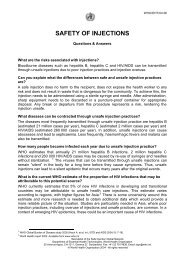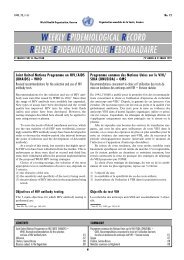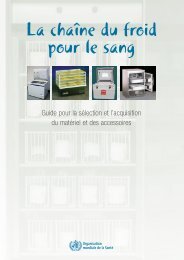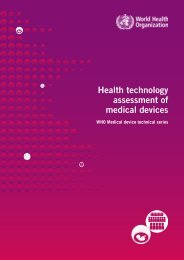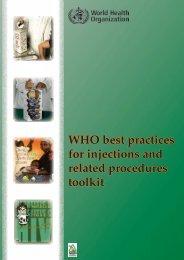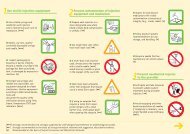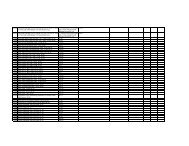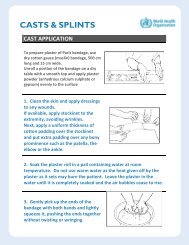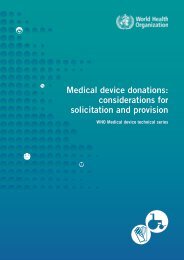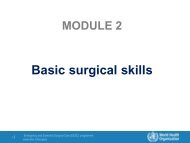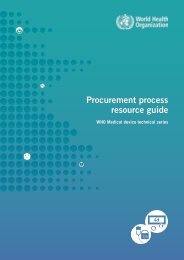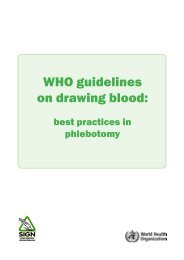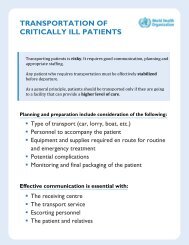SIGN meeting report 2003. - World Health Organization
SIGN meeting report 2003. - World Health Organization
SIGN meeting report 2003. - World Health Organization
Create successful ePaper yourself
Turn your PDF publications into a flip-book with our unique Google optimized e-Paper software.
Ensuring quality assurance for single use injection devices<br />
The pre-market phase of injection devices includes conception, design, manufacture,<br />
packaging and labeling. At this stage, norms and standards regulate the product.<br />
Standards guarantee effectiveness, ensure quality and provide safety. Standards are<br />
voluntary while regulations are mandatory. The ISO standards for single use syringes<br />
and needles describe characteristics for general safety and performance of the product.<br />
The International <strong>Organization</strong> for Standardization (ISO) agreed to work on a new<br />
standard for hypodermic syringes with a reuse prevention feature for general purpose<br />
(projected ISO standard 7886-4), while the committee is finalizing the draft standard for<br />
AD syringes for immunization that is labeled ISO 7886-3, “Sterile hypodermic syringes<br />
for single use – part 3: Auto-disable syringes for fixed dose immunization.” In the<br />
absence of ISO standards, WHO will provide procurement specifications and laboratory<br />
test procedures, but will refer to ISO standards when available. Only a limited number<br />
of countries have established national regulations for medical devices. The five<br />
founding members of Global Harmonization Task Force (GHTF) have medical device<br />
regulations that can be used as a basis for pre-qualification by WHO. By developing<br />
quality control and reinforcing medical device regulations, more countries will be able<br />
to maximize the benefits to the patient so that injection use can be appropriate and<br />
consistent with an approach that minimizes the risks.<br />
Proposed WHO pre-qualification procedure for the procurement of injection devices by United<br />
Nations agencies<br />
WHO and other United Nations (UN) agencies, as potential supply agencies for<br />
developing countries, may have a role in procuring single use injection devices. The<br />
purpose of the quality assessment for single use injection devices is to verify that<br />
injection devices meet the specifications of the relevant UN agencies and are produced<br />
and controlled in accordance with product standards or WHO procurement<br />
specifications and quality system standards recommended by WHO. The assessment<br />
will determine reliable sources of procurement of single use injection devices to ensure<br />
quality and to guide other UN agencies in sourcing of such devices. The quality<br />
assessment procedure is based upon three main principles, (1) conformity with the UN<br />
agencies’ specifications and ISO product standards and/or WHO template<br />
specifications; (2) documentation of the quality system in place for production of<br />
medical devices, through compliance with acceptable quality system standards and (3)<br />
monitoring by WHO, in collaboration with the manufacturers, of verified complaints<br />
from the field and/or from UN agencies. At present, the proposed procedure relies<br />
mostly on the regulations formulated by the five founding members of the Global<br />
Harmonization Task Force (GHTF), as most developing countries do not have national<br />
regulations for medical devices. By 2004, WHO will assess all manufacturers who wish<br />
to have their products pre-qualified for procurement of single use injection devices by<br />
UN procurement agencies. The conformity of auto-disable syringes selected according<br />
to WHO procurement specifications will still be tested by WHO accredited laboratories<br />
until the ISO standard is finalized and approved.<br />
Suggestions from the International Association for Safe Injection Technologies (IASIT) on the<br />
role of WHO in technology transfer and technology implementation activities<br />
William Dierick<br />
IASIT, Geneva, Switzerland<br />
Suggestions from IASIT to WHO on the proposed terms of references of WHO in technology<br />
transfer activities<br />
WHO drafted terms of reference for its role in technology transfer activities (i.e., set-up<br />
of production of auto-disable syringes in developing countries). As a WHO partner and<br />
at the request of WHO, IASIT wishes to make suggestions on these terms of references.<br />
IASIT views WHO as a promoter of safe technologies and as a resource to introduce<br />
14



